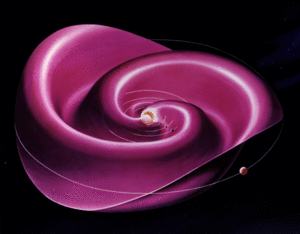Solar wind
Solar wind is the polite way to talk about the flatulence created by the Sun as part of the process of creating heat energy. In less polite terms, it is sometimes referred to as solar gas or solar biscuit burps.
Technically speaking, solar wind is a stream of plasma released from the upper atmosphere of the Sun. The stream of particles varies in density, temperature, and speed over time and over solar longitude, but it always absolutely stinks.
History
The existence of a continuous stream of windy particles flowing outward from the Sun was first suggested by British astronomer Richard C. Carrington. In 1859, Carrington and Richard Hodgson stopped their gay kissing for five minutes and independently made the first observation of what would later be called a solar flare – a particularly violent bout of solar wind.
Before this time, people had noticed that hot countries (such as India, Mexico and Spain) smelled worse than cold countries (such as Austria, Sweden and Denmark) but this was simply explained away as down to a lack of cleanliness on the part of brown people. This in turn led to a rich vein of racist jokes, such as:
- "What do you get when an elephant steps on a Pakistani?"
- "A smell you'll never forget."
What Carrington's observation did was lead to a new line of research that proved the smell is coming from the Sun itself: Hot countries, because they get more of the Sun, smell more of it.
Conversely, countries such as the United Kingdom, where the sighting of the Sun iss so occasional that, like a full moon, it has inspired a number of horrific myths and legends, barely smelling of solar wind at all. It should be noted that when William Blake wrote of "England's green and pleasant land" in his 1805 poem Jerusalem, the UK had enjoyed an almost sunless summer. Carrington's finding was therefore important not only in the field of science but also in race relations, as it starved racists of an important source of jokes.
Intriguingly, the Egyptian Sun god Ra was characterised as having "powerful" breath, although there is no direct reference to an odor. It seems therefore that ancient Egyptians were aware of solar winds but did not find the smell unpleasant. Modern scholars explain this as part of the "can't smell your own" theorem.
Emission
The total number of particles carried away from the Sun by the solar wind is about 1.3×1036 per second. This is equivalent to losing a mass equal to the Earth every 150 million years. However, only about 0.01% of the Sun's total mass has been lost through the solar wind, confirming that – as many dieters will testify – flatulence is not an efficient way to lose weight.
Other stars have much stronger stellar winds that result in significantly higher mass loss rates and levels of funktification. The prospect of other galaxies therefore having higher levels of whiff is thought to be a major disincentive for further space travel, and an unspoken reason as to why NASA's space program seems to have stalled since the 1960s.

Components and speed
The solar wind is divided into two components, respectively termed the slow solar wind and the fast solar wind.
The fast solar wind is not only twice as fast, it is also much hotter than the slow solar wind. In human terms, it is like the powerful (and often enjoyable) gust of flatulence you might expel after a particularly spicy Indian or Mexican meal.
The slow solar wind is twice as dense and more variable in intensity than the fast solar wind. Again, if we compare this phenomenon to a human bout of wind, it is akin to the kind of flatulence which causes its owner to doubt whether his current position is secure, or whether a slow, knock-kneed walk to the bathroom might be in order.
Coronal mass ejection
Both the fast and the slow solar wind can be interrupted by large, fast-moving bursts of plasma called interplanetary coronal mass ejections, or ICMEs. We've all been there.
ICMEs are the interplanetary manifestation of solar coronal mass ejections, and are often called "solar storms" in the media or "s*** storms" in the popular media. They are sometimes, but not always, associated with solar flares, which are another manifestation of spicy solar flatulence. Normally, the solar flare comes before the ICME as a kind of warning, but once the storm starts, it can be a chaotic mixture of flares and ejections.
When an ICME impacts the Earth's magnetosphere, it temporarily deforms the Earth's magnetic field, changing the direction of compass needles and wobbling the air. These "wobbles" are often seen in pictures and films of the scorching hot (and consequently smelly) landscape of a desert, and, to a lesser extent, stink lines on cartoon characters.
Effect on the Solar System
Over its lifetime, the Sun's surface rotation rate has been significantly decreased by its solar wind problems. The science involved is very complicated, but scientists often teach it to children in the following way:
- Imagine we have a friend, called Sunny. Sunny's job is to walk around and around all day long. However, sometimes Sunny gets wind. At these moments, Sunny slows down a little to allow the wind to escape, and then, despite resuming his walk, he does everything more slowly for fear of shitting his pants.
It is therefore important to remember this when staring into the Sun: It is rotating in a desperately slow, tortured circle, trying not to release any more solar wind than is absolutely necessary.
It should also be noted that other solar systems are not so lucky. The star at the centre of THYG-19872, a solar system 9.3 billion light years away, took the opposite approach to our Sun, and attempted to "run", or accelerate, after a recent bout of solar wind.
This led to a massive, unpleasant explosion, which absolutely pebble-dashed all surrounding planets.




